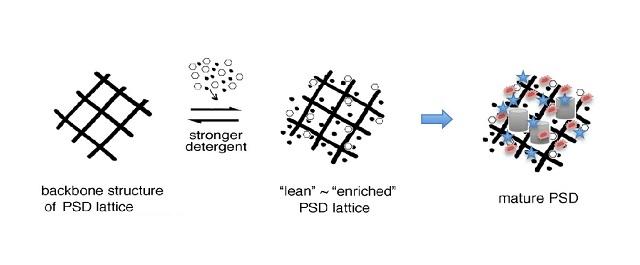A research group led by Dr. Tatsuo Suzuki, Specially Appointed Professor of the Department of Molecular and Cellular Physiology of Shinshu University School of Medicine, Dr. Katsuhiko Tabuchi, Professor of the Institute for Biomedical Sciences/the Department of Molecular and Cellular Physiology of Shinshu University School of Medicine and Dr. Weidong Li, Professor of Bio-X Institutes, Shanghai Jiao Tong University/Distinguished Visiting Professor of the Institute for Biomedical Sciences developed a new purification protocol for Postsynaptic density (PSD) lattice, a core structure of the PSD of excitatory synapses in the central nervous system. The components of the PSD lattice were identified by comprehensive shotgun mass spectrometry and categorized as either minimum essential component (MEC) or non-MEC proteins. Tubulin was found to be a major component of the MEC, with non-microtubule tubulin widely distributed on the purified PSD lattice. The presence of tubulin in and around PSDs was verified by post-embedding immuno-gold labeling EM of cerebral cortex. This study newly identified the PSD lattice backbone structure and provides a new PSD architecture model comprising a non-microtubule tubulin-based backbone structure and its associated proteins, including various PSD scaffold/adaptor proteins and other PSD proteins.
The results will be published in the international, open-access journal Life Science Alliance on May 18th.
See below for details.
Author: Suzuki T., et al.
Title: Non-microtubule tubulin-based backbone and subordinate components of postsynaptic density lattices
Journal: Life Science Alliance
DOI: 10.26508/lsa.202000945
EurekAlert!: https://www.eurekalert.org/pub_releases/2021-05/su-pdc051321.php
The results will be published in the international, open-access journal Life Science Alliance on May 18th.
See below for details.
Author: Suzuki T., et al.
Title: Non-microtubule tubulin-based backbone and subordinate components of postsynaptic density lattices
Journal: Life Science Alliance
DOI: 10.26508/lsa.202000945
EurekAlert!: https://www.eurekalert.org/pub_releases/2021-05/su-pdc051321.php


